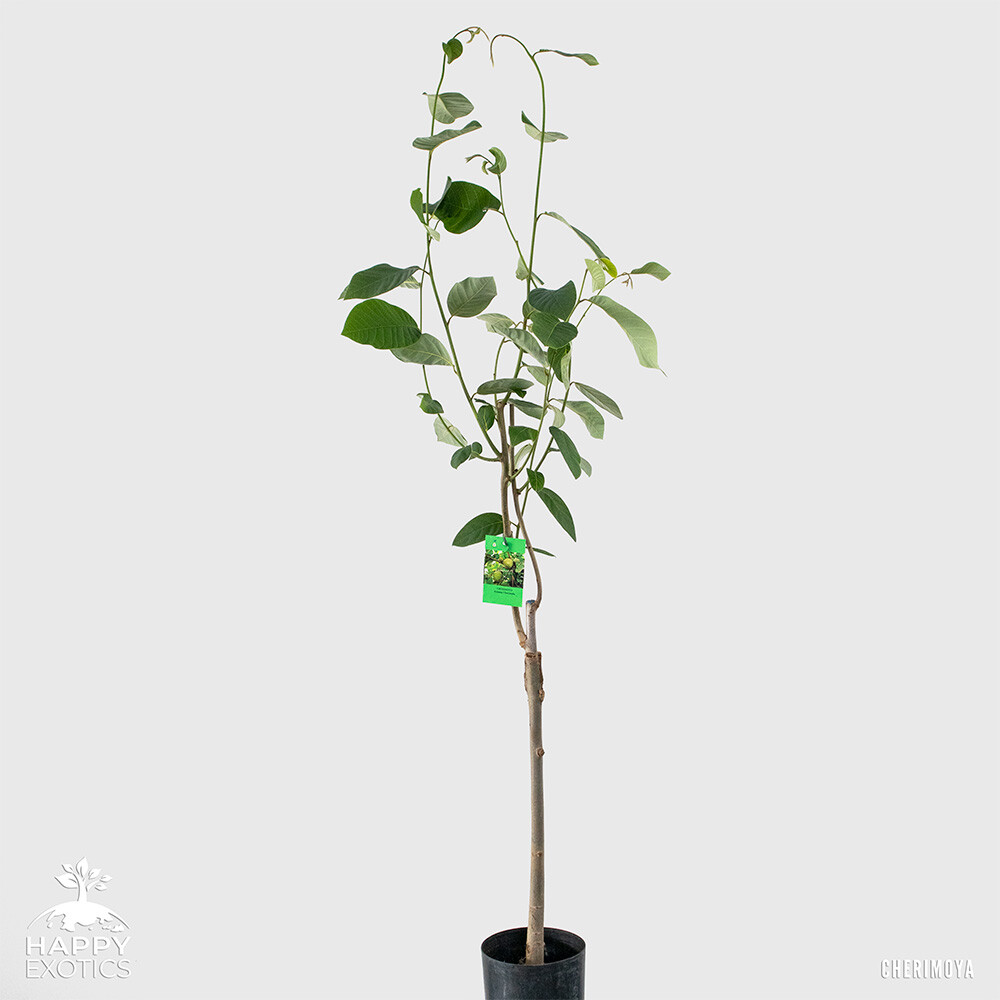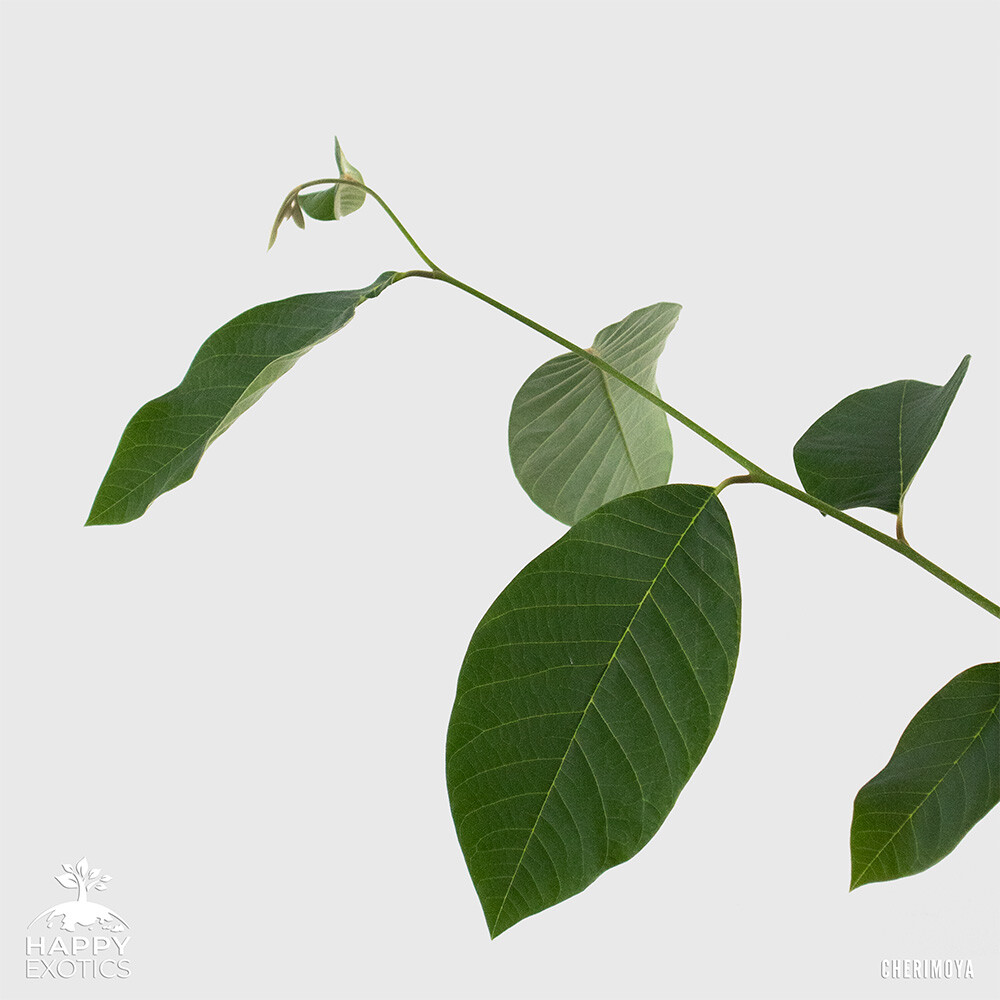1 happy Cherimoya tree grafted Fino de Jete – Annona cherimola
€69.95
13 in stock

13 in stock

Fast EU shipping

Grown in our own nursery
The cherimoya tree, scientifically known as Annona cherimola, is a tropical fruit tree native to the Andean highlands of South America. It belongs to the Annonaceae family, which includes other delicious fruits like soursop and custard apple. Cherimoya trees are now cultivated in various regions worldwide with suitable climates.
In Europe the the fruit's popularity and demand have led to successful cultivation attempts in select European areas with suitable climates. Southern regions of Spain, particularly the coastal areas of Andalusia has a favorable climate for cherimoya cultivation. Other Mediterranean countries such as Italy, Greece, and Portugal also have some cherimoya cultivation, albeit on a smaller scale.
The cherimoya tree is a small to medium-sized evergreen tree that can reach heights of 6 to 9 meters. When cultivated, the trees are pruned back to a desired height of around 2 meters. It has a pyramid-like shape with a rounded crown and a relatively short trunk. The leaves are large, oval-shaped, glossy, and deep green in color, providing a lush appearance to the tree.
One of the most distinctive features of the cherimoya tree is its flowers. They are peculiar, fragrant, and unique, with three fleshy outer petals that are greenish-yellow or brownish, and three smaller, more narrow inner petals that are pale yellow or green. The flowers are pollinated by beetles, bees, or flies and develop into the delicious fruit for which the tree is known.
Cultivating cherimoya trees can be a rewarding experience, as they offer both ornamental beauty with their lush foliage and striking flowers, as well as delicious fruits with a unique taste. The tree's tropical origins and delightful fruit make it a favorite among fruit enthusiasts and gardeners seeking to add exotic flavors to their home orchards.
Cherimoya fruit - Fino de Jete
This is a grafted Cherimoya tree in a 6 liter pot, including pot circa 120cm high. The rootstock is a Cherimoya seedling, with a Fino de Jete cultivar grafted. The Fino de Jete is a specific cultivar of cherimoya (Annona cherimola) known for its exceptional flavor and quality. It is named after the village of Jete in the province of Granada, Spain, where it originated and is primarily cultivated. The Fino de Jete cultivar is highly regarded among cherimoya enthusiasts for its superior taste and unique characteristics.
The Fino de Jete cherimoya has several distinct features that set it apart from other cultivars. The fruit is generally medium to large in size and has a heart-shaped or rounded shape. Its skin is green and covered with small, cone-shaped protuberances or bumps. The surface may also exhibit slight cracks or fissures as the fruit ripens.
What truly makes the Fino de Jete cherimoya standout is its exceptional flavor. The flesh of this cultivar is incredibly creamy, smooth, and custard-like. It has a delicate, sweet taste with subtle hints of tropical flavors such as pineapple, banana, and strawberry. Many consider it to be one of the best-tasting cherimoya varieties available.
Additional information
| Weight | 4 kg |
|---|---|
| Dimensions | 17 × 17 × 130 cm |
Properties & Care
How to take care of a Cherimoya tree
- Climate and Location: Cherimoya trees thrive in warm, frost-free climates like most of our trees. Choose a sunny location with well-drained soil. If you live in a colder region, consider growing the tree in a greenhouse or a protected area. It has been proven to fruit also in Berlin for example.
- Watering: Cherimoya trees require regular watering to keep the soil consistently moist but not waterlogged. Water deeply and allow the top inch of soil to dry out before watering again. During the fruiting season, ensure adequate watering to prevent fruit drop.
- Fertilization: Apply a balanced, slow-release fertilizer formulated for fruit trees in early spring. Follow the manufacturer’s instructions for dosage. Additionally, supplement with organic matter like compost or well-rotted manure to improve soil fertility.
- Pruning: Prune the tree during the dormant season to maintain its shape, remove dead or damaged branches, and improve airflow.
- Pollination: Cherimoya trees are primarily pollinated by beetles, bees, or flies. If you have a small tree or limited pollinators in your area, hand pollination may be necessary. Gently transfer pollen from the male flowers to the female flowers using a small brush or cotton swab.
- Pest and Disease Control: Monitor the tree for common pests like aphids, mites, and fruit flies. Use organic insecticides or horticultural oils if necessary. Watch for signs of fungal diseases like powdery mildew or root rot, and take appropriate measures such as applying fungicides or improving drainage.
- Support: As the tree grows, provide support in the form of stakes or trellises to prevent damage from strong winds or heavy fruit loads.
- Harvesting: Cherimoya fruits are typically harvested when they reach maturity and give slightly to gentle pressure. Depending on the cultivar, the skin may turn slightly yellow or develop cracks as a sign of ripeness. Harvest carefully to avoid bruising.
FAQ
Propagation
The Cherimoya tree can be propagated through its seeds or veneer grafting.
Shipping & Returns
To ensure that it’s delivered in perfect condition, your bael tree will be shipped in custom plant mail-order extra heavy cardboard packaging.
WARRANTY AND RETURNS
Despite the high quality of our products, it can occur that you receive a product that is not perfect. If that happens we’d like to provide you with a suitable solution as quickly as possible.
ALWAYS 2 YEARS WARRANTY
We are convinced of the quality of the products we offer. Therefore we always give 2 years guarantee on all your purchases.
14 DAY MONEY-BACK PERIOD
Curryelaftree.com operates a 14 day approval and inspection period for all online orders. This period starts when you have received the product. After 14 days the purchase agreement becomes final. During this period you should handle the product and packaging carefully, if reasonably possible. Try the product out to the extent necessary in order to decide whether you wish to keep it. The product can be vieuwd and reviewed, as you would do in a shop. When there is damage to the product or its packaging, this will be deducted from the return. When the product is used in this period, and now returned, the costs for use, such as cleaning or repair costs, will be deducted from the return. When you return a product within the 14 day money-back period, we are obliged to pay you the purchase price, including shipping and any debit or administration costs, back within 14 days from receiving your return.
DAMAGE UPON RECEIPT
All products are packaged safely and checked by Curryleaftree.com before shipping. If you nevertheless do receive a damaged product, please report the damage before returning the order.
RETURNS PROCEDURE
There are a number of reasons you may decide to return (a part of) your order. Read this information through carefully to avoid any misunderstandings and delays. If you wish to return a product, the method of shipment and the condition of the product must comply with our stated terms and conditions below.
Returns Form
For the return of a shipment contact us first. By filling in a form and sending it to us, you let us you know that you want to return your shipment. When we have received this form, we will start processing your return. You can always email us to discuss your return.
Return Shipment and Costs
The correct postal franking costs must always be paid for a return shipment. Packages not correctly franked or marked as returned subject to payment on delivery will not be accepted by us. Curryleaftree.com reimburses the postal costs after returning in case the return is a result of an mistake by Curryleaftree.com or when there is a defective product. If you are entitled to a refund of the shipping costs, we apply a maximum fee. You can also choose to bring the product back or exchange it at the Curryleaftree.com office. This is fast, easy and free of charge. The maximum fee for a return shipment is € 6,95 within the Netherlands, € 9,95 for Belgium and Germany, € 25.95 for the rest of Europe and € 29,00 for the rest of the world.
Return Address
Curryleaftree.com
Warranty and Returns
Tolweg 2W 3851 SK
Ermelo The Netherlands
Only logged in customers who have purchased this product may leave a review.



Reviews
There are no reviews yet.